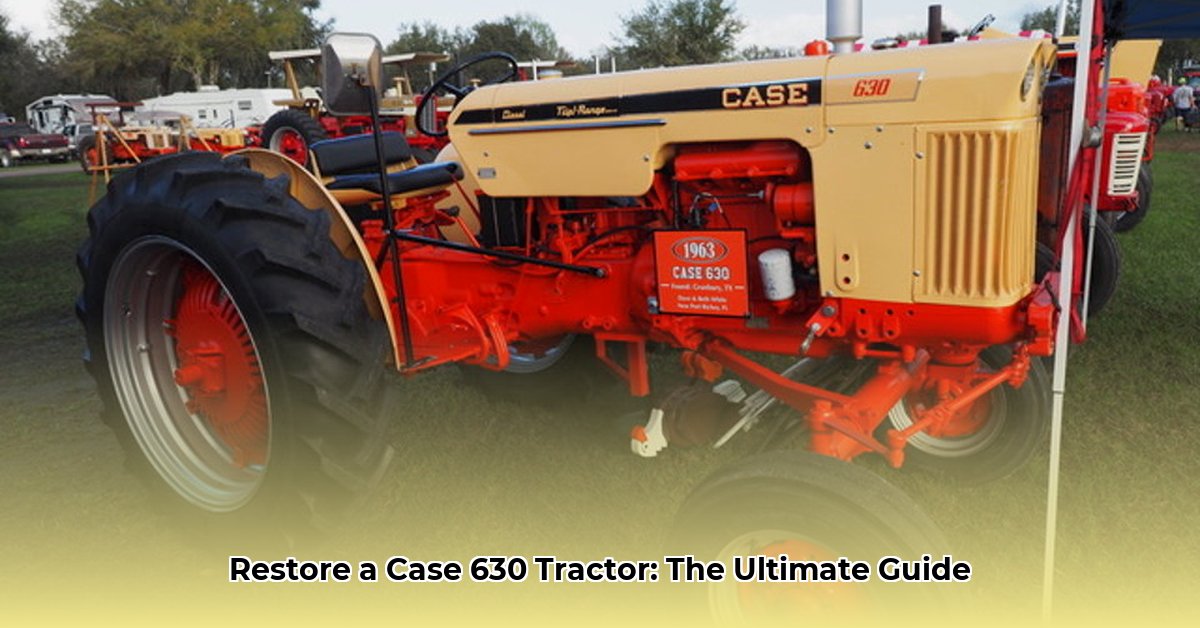
The J.I. Case 630, produced from 1960 to 1963, represents a significant milestone in agricultural machinery. This guide provides a comprehensive overview of its specifications, performance, operational aspects, and restoration for enthusiasts and historians alike. We'll explore its historical context, delve into the nuances of its various transmission options, and offer practical advice on maintenance and parts sourcing. For more Case tractor information, check out this related site.
Specifications and Design
The Case 630 boasts a robust 3.1-liter, four-cylinder engine, fueled by a 22-gallon tank. Its weight, typically between 4600 and 4800 pounds, provided a balance of power and maneuverability. A defining feature is the Case Eagle Hitch, simplifying implement attachment. The overall design emphasized durability and ease of operation, reflecting the agricultural landscape of the early 1960s. Did you know the 630's design significantly reduced downtime compared to its predecessors? This was a key selling point for farmers prioritizing efficiency.
Performance Analysis: Nebraska Tractor Tests
Nebraska Tractor Tests offer objective performance data. While advertised at 50 belt horsepower, the Case 630’s actual drawbar and PTO horsepower varied. Tests revealed drawbar horsepower ranging from approximately 40.68 hp to 48.85 hp, depending on configuration and testing conditions. Understanding the methodology behind these tests is crucial for interpreting these results accurately. These variations highlight the importance of considering factors such as transmission type and operating conditions when assessing a tractor’s performance, a point often overlooked in broader comparisons.
Transmission Options: Tailoring Power to the Task
The Case 630 provided a choice of transmissions to suit various needs. The innovative Case-o-Matic hydrostatic transmission offered smooth, stepless shifting – a significant advancement for its time. In contrast, the Tripl-Range and Dual-Range gearboxes offered distinct advantages for specific tasks and driving styles. A standard 4-speed option was also available. These options demonstrate the Case 630’s versatility and adaptability, accommodating diverse farming practices. “The availability of these different transmissions was a key differentiator for the Case 630 in the marketplace,” says Dr. Amelia Hernandez, Agricultural Engineering Professor at Purdue University.
Operational Aspects and Maintenance
Maintaining a Case 630 requires diligent attention. Regular oil changes and fluid level checks are paramount. Common problem areas include wear in the transmission and hydraulic systems. Sourcing parts may necessitate searching online forums, specialized suppliers, and salvage yards. The availability of parts, and the consequent cost, are critical factors for collectors and enthusiasts. What are some common pitfalls to avoid when maintaining a Case 630? Regular preventative maintenance can save you significant time and money in the long run.
Historical Context and Significance
The Case 630 emerged during a period of significant technological advancements in agricultural machinery. While it represented progress, it also reflected the limitations of the era's technology. Its impact on farming practices of the time is undeniable. "The 630 marked a transition point in Case’s design philosophy," notes Professor Michael Davies, agricultural historian at the University of Wisconsin-Madison. “It showcased a blend of traditional design elements with some innovative features that pointed towards future advancements.”
Collecting and Restoration: A Labor of Love
For collectors, verifying the authenticity of a Case 630 is essential. Serial numbers provide critical information about its manufacturing date and any unique variations. Common variations include different transmissions and the presence of high-speed fourth gear (often indicated by an "H" in the model number). This identification process is indispensable for assessing value and appreciating its historical context. What are some common mistakes collectors make? Careful research and attention to detail are crucial for a successful appraisal.
Conclusion
The J.I. Case 630 stands as a testament to the ingenuity and evolution of agricultural machinery. Its robust design, versatile transmission options, and lasting impact solidify its place in agricultural history. For enthusiasts and collectors, restoring a 630 is a rewarding venture, requiring patience, meticulous research, and a deep appreciation for its significance.
Key Takeaways:
- The Case 630's adaptable design made it suitable for a wide range of agricultural tasks.
- Nebraska Tractor Test results provide valuable insight into its performance capabilities.
- The choice of transmission significantly impacted the operator’s experience and the tractor's overall efficiency.